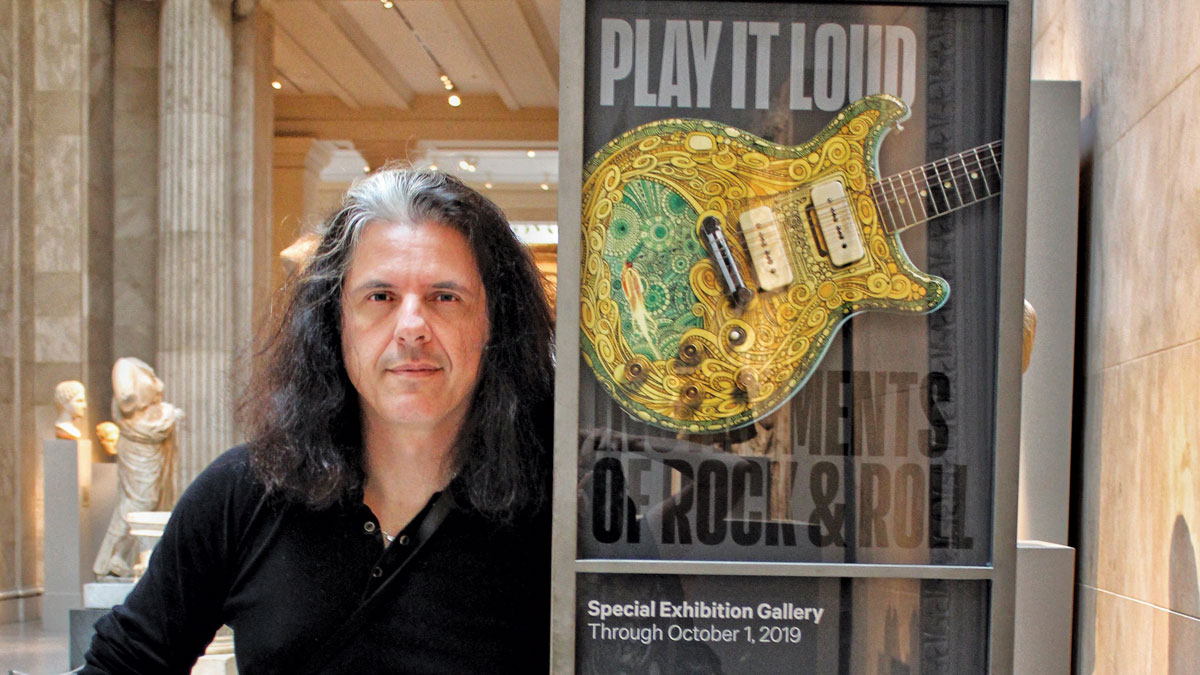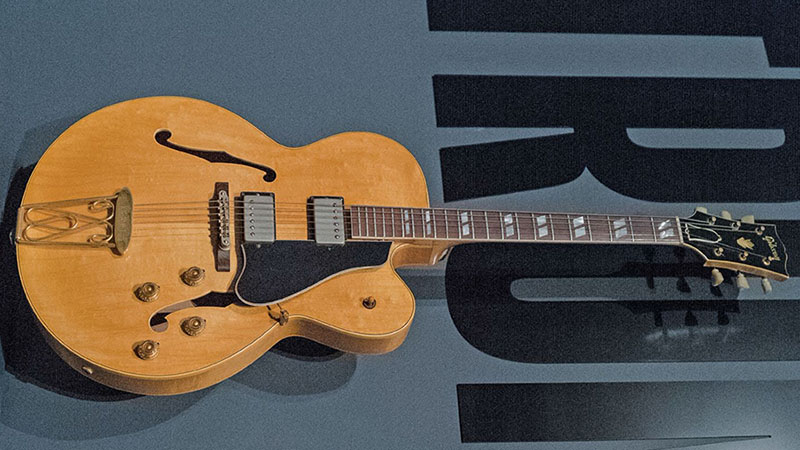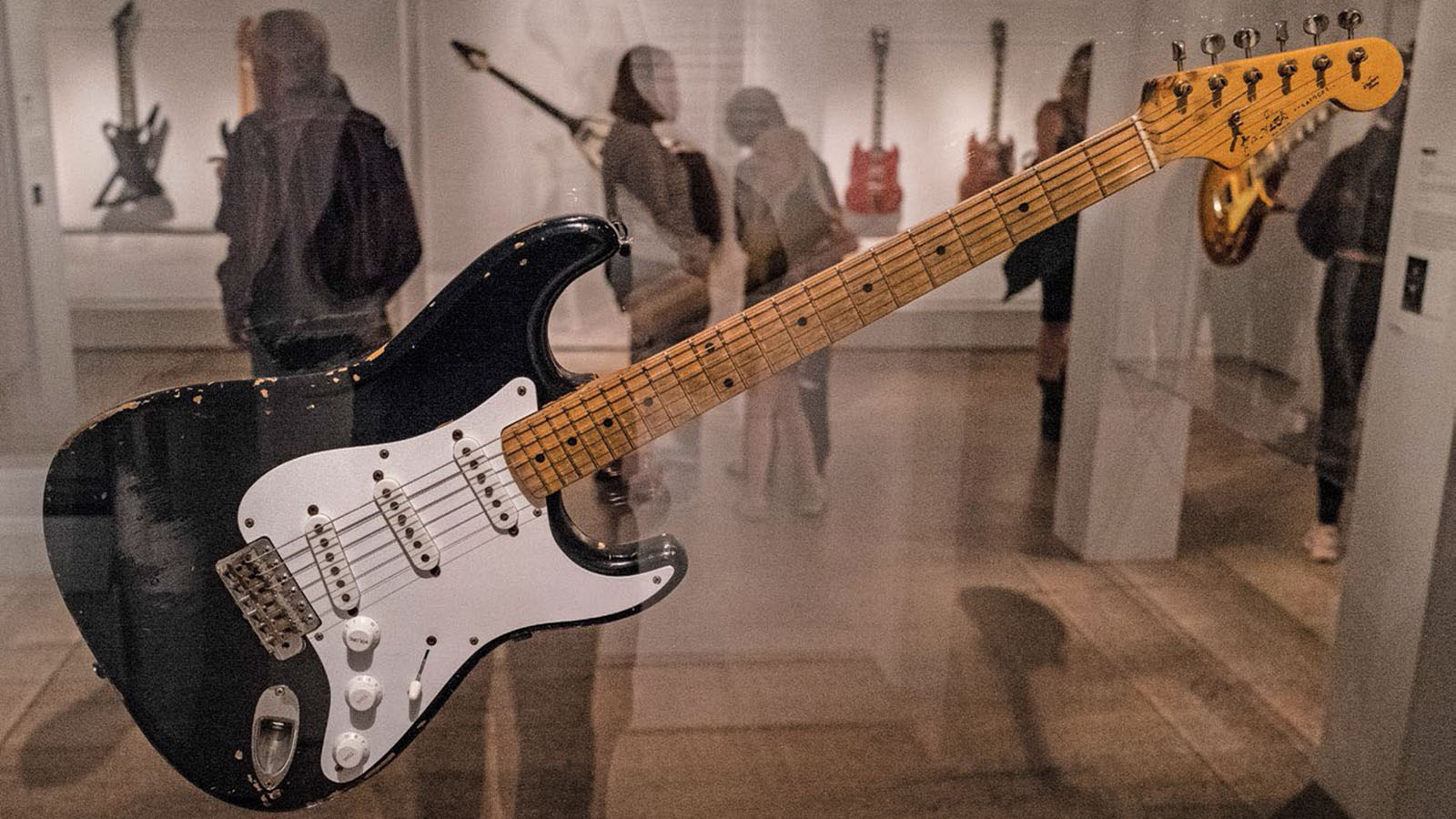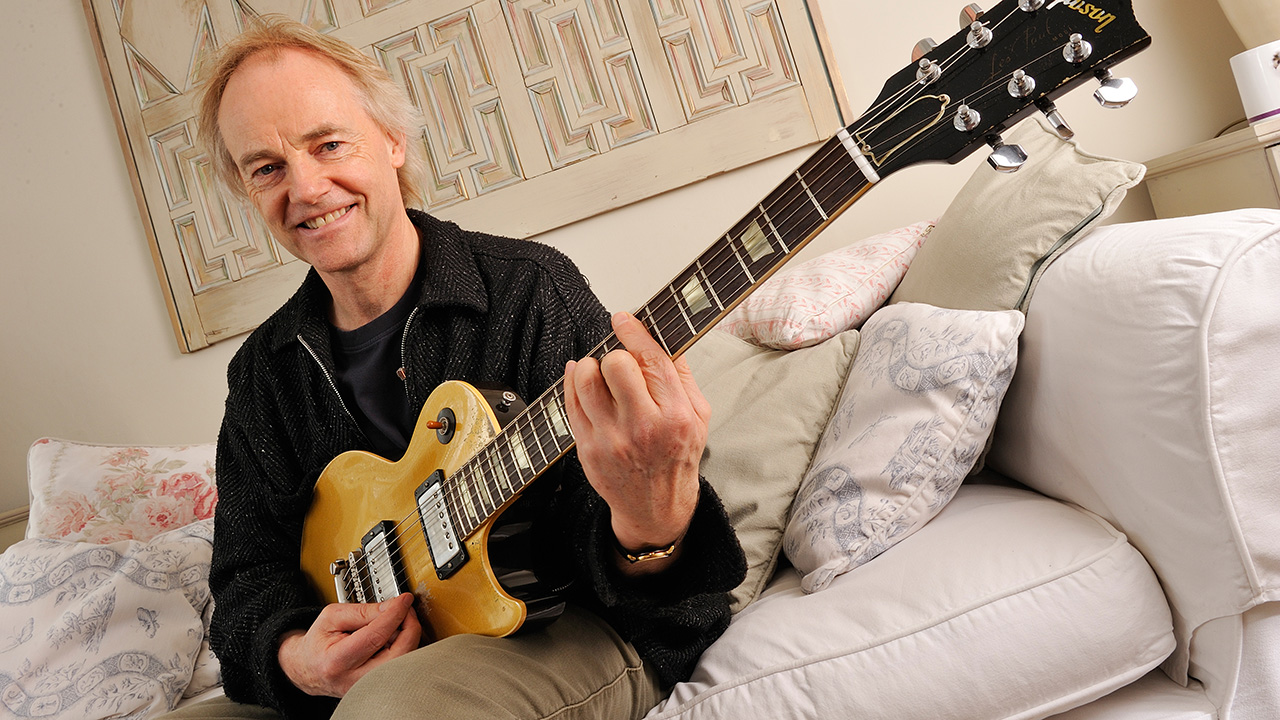Alex Skolnick takes you on a guided tour of the Met's astonishing Play It Loud guitar exhibition
The Testament guitarist picks his highlights from the New York museum's 70+ priceless instruments

Testament’s Alex Skolnick is like a kid in a candy store. Except that New York City’s Metropolitan Museum of Art isn’t a store, and these delights - which are safely displayed behind glass - are legendary guitars made famous by Eddie Van Halen, Eric Clapton, Jimi Hendrix and other rock and roll giants.
From Van Halen’s Frankenstein to Clapton’s Blackie, Skolnick is familiar with nearly all the instruments in the exhibit - and even has a story or two about most of them
From Van Halen’s Frankenstein to Clapton’s Blackie, Skolnick is familiar with nearly all the instruments in the exhibit - and even has a story or two about most of them. It’s the guitarist’s second visit to Play It Loud: Instruments of Rock & Roll, a monumental exhibit that runs through October 1 at the Met before scaling down a bit and heading to Cleveland’s Rock and Roll Hall of Fame.
He also attended the April grand opening, as did Jimmy Page, who loaned the exhibit several historic items and axes, including his original Fender 'Dragon' Telecaster, the one he used in his Yardbirds days and on Led Zeppelin’s self-titled 1969 debut.
Before even entering the exhibit, Skolnick spies the Chuck Berry guitar that - appropriately - marks the start of Play It Loud, his circa-1958 'Johnny B. Goode' Gibson ES-350T.
Skolnick cites Berry as a major influence, discovering him in 1978.
“That’s when a film called American Hot Wax came out. I was 10, and [Berry] played himself in the film and stole the show,” recalls Skolnick.
“I’d heard ‘Johnny B. Goode’ on the radio, but I didn’t know who it was - or anything about Chuck Berry.
All the latest guitar news, interviews, lessons, reviews, deals and more, direct to your inbox!
“He did a song in the film called ‘Reelin’ and Rockin’.’ He has a couple of lines in that song that are hilarious - children’s humor. The one I remember is, ‘I boogied in the kitchen, I boogied in the hall, I boogied on my finger; wiped it on the wall.’”

Realizing a rock-instrument show could never be encyclopedic, its organizers went for a more thematic approach. One of the coolest things about the exhibit?
“We have a lot of pieces from players that are actually still in use, like Keith Richards’ ‘Micawber’ [Fender Telecaster],” says Jayson Dobney, the exhibit’s curator. “It’s kind of amazing that he would lend us one of his main axes.”
One of the motivating factors for the show was the book Play It Loud: An Epic History of the Style, Sound, and Revolution of the Electric Guitar [Doubleday, 2016], by Brad Tolinski and Alan di Perna, that gave the exhibit its name.
“There’s a line [in the book] about rock and roll - how the ‘tone color’ and attraction to amplifiers, feedback, distortion, effects and all that good stuff is so, so important,” Dobney says.
Play It Loud has 70 lenders, people who lent everything from instruments to costumes - an unusually high number, to say the least
“That’s not true in jazz, country and other genres. That was one of the big milestones for that little germ of an idea.” Another, Dobney adds, was witnessing Don Felder’s guitar tech walk on stage with the former Eagles guitarist’s iconic white doubleneck Gibson EDS-1275 and seeing the crowd go wild.
“I thought, ‘Well, there’s the visual part of it. We have the visual part, we have the musical part. I think we can run with it.’ This show is a conversation about instruments.”
Play It Loud has 70 lenders, people who lent everything from instruments to costumes - an unusually high number, to say the least. Skolnick, who owns around 40 guitars, which he uses with Testament, the Alex Skolnick Trio, Metal Allegiance and other jazz and world-music projects, says he’s especially excited to see “Prince’s guitar, Clapton’s ‘The Fool’ SG and ‘Blackie’ Stratocaster, plus Stevie Ray Vaughan’s ‘Number One’ [Strat], [Eddie] Van Halen’s ‘Frankenstein’ and Jimi Hendrix’s Woodstock Strat up close and in person.”

Walking through the exhibit, Skolnick is so taken by Eddie’s Frankenstein axe - even photographing it with a Leica camera he bought on the advice of Lamb of God’s Randy Blythe - that he doesn’t notice museum patrons taking surreptitious photos of him. But no-one is brave enough to approach, and he walks through the exhibit like any other rabid rock fan.
The first few rooms are dedicated to pioneers of early rock, and gazing at an Elvis Presley guitar, Skolnick muses, “It’s a Martin [D-18] acoustic, and you’re only going to have a Martin acoustic in between Jerry Lee Lewis and the Beatles if it’s somebody on that [big] level. Usually the acoustics are more folk. That’s a beauty. I have a Martin, but not like that one - [mine’s from] much later; that’s a ’42.”
Up next is Bo Diddley’s rectangular 1960 Gretsch 'Twang Machine'. “I met him once; I have a great photo of me and him from the late-'80s,” Skolnick says.
I would guess George Harrison’s 1958 Höfner Club 40 hasn’t been played in years; the strings are so high off the neck. It would be very hard to play what you wanted to play on this
“It [was] very ambitious of him to do that with the shape. He didn’t have to get very technical, so it worked for him. It’s not unlike the guitar made by Ned Steinberger. They were better for basses; Sting played one, but it definitely didn’t catch on.”
Some vintage Beatles gear, including Ringo Starr’s 1963 Ludwig Downbeat drum set, can’t help remind attendees of the Beatles’ legendary February 9, 1964, appearance on The Ed Sullivan Show.
“I just walked by [The Late Show with Stephen] Colbert, which is in the Ed Sullivan Theater on Broadway,” Skolnick says.
“I went there for one of [David] Letterman’s last shows. It’s the same stage [The Beatles] played on. It’s really tiny, such a little soundstage. But when it was broadcast, the event was larger-than-life, you didn’t realize it. It’s shocking how small it is. I feel that same thing, looking at Ringo’s [little] kit.”
Examining George Harrison’s 1958 Höfner Club 40, Skolnick says, “I would guess this hasn’t been played in years; the strings are so high off the neck. It would be very hard to play what you wanted to play on this.”
It will come as little surprise that Eric Clapton is well represented - the exhibit includes Blackie, the guitarist’s legendary composite Fender Stratocaster.
Clapton’s guitar tech, Ted Newman-Jones, assembled Blackie from the best parts of three late-'50s Strats Clapton bought from Sho-Bud Steel Guitar Co. in Nashville in 1970. Clapton bought three other Strats at the store, giving one each to Harrison, Pete Townshend and Steve Winwood.
Clapton first played Blackie live at London’s Rainbow Theatre on January 13, 1973, in a concert organized by Townshend.

On the Clapton tip, Skolnick mentions Duane Allman’s luminous 1957 Gibson Les Paul Goldtop that was played on Layla, a guitar that is not part of the exhibit. But that’s OK - Skolnick has seen it before.
“I went to one of the last Allman Brothers Band shows at the Beacon [Theatre in New York City]. The keeper of that guitar is a fan [of mine] and offered to let me play it. I have some photos with it. It’s the guitar. It was amazing. I probably played something inappropriate. I think I played blues; what else could you play?”
Skolnick, who studied with Joe Satriani early in his career, is no stranger to shredding in the spotlight; however, aesthetically and personally, he lays low. Not so Buddy Holly, whose wartime Gibson J-45 is covered in leather.
I met Les Paul and played with his band at the Iridium [jazz club in New York City]... My signature ESP guitar has a shape not unlike a Les Paul
As the museum catalog notes, “Holly was a leather-tooling enthusiast and possibly made the cover himself, building it directly onto the guitar.”
Other guitars are sticker-clad, including Joe Strummer’s 1966 Fender Telecaster and Joan Jett’s 1977 Gibson Melody Maker. Skolnick is more of a purist; no decorations on guitar straps, no stickers - and he’s never named one of his guitars. “I keep it simple,” he says.
Gazing at a 1958 Gibson Explorer owned by New York record producer/collector Perry A. Margouleff, Skolnick riffs, “Of course, made famous by James Hetfield and the Scorpions. I’ve never had one. I’ve played a couple that I’ve liked, but I’m very selective about which guitars I own, for reasons of space.”
Gibson Les Pauls abound, giving rise to discussion of the man whose name is on the headstock.
“I met Les Paul and played with his band at the Iridium [jazz club in New York City], but never with Paul himself,” Skolnick says. “My signature ESP guitar has a shape not unlike a Les Paul. When we were considering how to build it, a couple of my favorite Les Pauls were considered blueprints for it, as well as some of the ESP models. I have two Les Pauls.”
The Beatles’ I Want to Hold Your Hand loops endlessly overhead, along with the Everly Brothers’ Wake Up Little Susie and other chestnuts of early rock, all of which segue into Derek and the Dominos’ Layla and Hendrix’s version of Bob Dylan’s All Along the Watchtower.
Tourists and locals of all ages meander through the crowded museum as Skolnick stops in front of the Ernie Ball Music Man axe used by Annie Clark, aka St. Vincent, who Skolnick first saw as a guitar tech.
“I went to see Tuck & Patti in the '90s, and they only had one road person, an attractive young woman. Years later I heard a St. Vincent interview, and she spoke about Tuck, who was her uncle, showing her how to play - and then it all made sense.”

For the Prince fan who expects to find guitars as dramatic as the performer himself, there’s the gold 'love symbol' guitar. It was designed and built by Jerry Auerswald in 1993 in the shape of the eponymous symbol Prince adopted after he got into a contract dispute with his label. But this isn’t the guitar Skolnick wants to see; he’s excited about another instrument used by the Minneapolis musician.
“This is the famous Prince guitar - decidedly unflashy,” he says, examining a Japanese-built Tele-style Hohner 'The Prinz' model, one of several Hohner axes owned and played by the late guitarist.
Prince bought his original Hohner from a gas station attendant because it matched his outfit
“It’s cheap; we avoided Hohners growing up. I mean, a harmonica company that makes guitars? But I guess this is a great one, and the story is amazing. [Prince] bought [his original Hohner] from a gas station attendant because it matched his outfit [He paid around $30 in the early-'70s, according to the placard]. But he always played it. In Purple Rain he had it; by then, he started using more exotic guitars, but there was always this model.”
Many of the guitars in the exhibit are so beat-up, it looks like you could get a splinter just looking at them; a few are nearly pristine.
Skolnick enjoys his own collection but has a hard-and-fast rule: “If I buy a guitar, I have to put it to use. That’s the deal.”
Hence, the handmade Gypsy-jazz-style guitar he bought in Paris. It can be heard on Django Tango, a track from the Alex Skonick Trio’s 2018 release, Conundrum. “It’s not my main style, but occasionally I’ll dive into the Django Reinhardt stuff - so I might as well have the right kind of guitar.”
Then there’s the Tele he bought in Nashville. “The Trio was on tour doing shows with Rodrigo y Gabriela, playing the Ryman Auditorium. Right down the street is a famous store called Gruhn Guitars. So I’m in there playing their Telecasters; one is like $10,000, the next one, from 1950, is in the $15,000 range.”
Then Skolnick picked up one with a $2,500 price tag. He figured they forgot a zero on the price. But no, it was a 2009 copy, a perfect re-creation of a 1951 Nocaster.
“I walked away, thinking, ‘The last thing I need is another guitar,’” he says. But when he went back to the Ryman and told Rodrigo the story, Rodrigo stopped the soundcheck and rushed back to the store with Alex, insisting that he buy it, saying, 'You have to get that guitar! We’ll always remember this day.'”
The store was closing when they returned, but Skolnick pounded on the door, flashed his credit card and was able to buy it. He played it that night at the Ryman.
If Clapton’s 'The Fool' SG is psychedelically gorgeous, its equally famous antithesis is Van Halen’s Frankenstein. Standing in front of it, Skolnick laughs, “This I don’t need to read about - I know everything about it.”
Van Halen, who is about 13 years Skolnick’s senior, was one of the main reasons Skolnick got into hard rock guitar and later, metal.
“At the time Eddie made this, in the '70s, this is like a Stratocaster, which, for the type of guitar playing he’s doing, is easier to play. But if you look at any of the other Stratocasters, they have the single pickup [ie, single-coil pickups], not the double pickup [ie, humbucker pickup].
“It was unheard of to have a Strat with a double pickup. But he just ripped it out, went to town on it, stuffed this double pickup in there. He needed mobility and a guitar that felt right, but he wanted more of a Jimmy Page or Tony Iommi type of sound. He plays it with all those wires sticking out. Now the replicas are like $20,000. You can just see his mind at work: total mad genius.”

Up next? Felder’s famous double-neck. “I have this exact model,” Skolnick says. “[It was a gift from] Paul O’Neill, creator of the Trans-Siberian Orchestra, may he rest in peace. I guess he thought I did a good job on the tour.
“There was one instrumental in the set where this guitar was featured. At the end of the tour, Paul said, ‘Take it home, keep it, just bring it out on the next tour.’ I ended up using it with my trio, just for layers, and I’ve composed a few things on it.”
Skolnick doesn’t only compose on guitar; in fact, a song that’s likely to end up on the new Testament album, which is due out this fall, began on bass.
“I do bass on a lot of my demos,” he says. “I have a Fender Marcus Miller. I like the sound of it; it’s natural wood, and even though it’s called ‘Jazz,’ a lot of rock artists have used it. The two main signature Jazz Fender basses are Geddy Lee and Marcus Miller. I tried them both, and they’re both great.”
It’s funny, because Testament is just so high-visibility compared to the other bands I have, so it’s assumed that’s mostly what I do
Of course, Skolnick is a respected and prolific jazz artist, although it’s difficult to shake his association with Testament’s distinctive brand of thrash. But after leaving the Bay Area band in the early-'90s, the Berkeley-born musician shocked everyone by switching coasts to attend the New School for Jazz & Contemporary Music in New York City.
While there, he began doing sideman gigs, including Jekyll & Hyde, the theatrical version of the Broadway show. It was also during this time that he formed his trio; they’ve released five records since 2002.
He’s done nine albums with Testament since 1987 and, as we mentioned earlier, number 10 is in the works.
“It’s funny, because Testament is just so high-visibility compared to the other bands I have, so it’s assumed that’s mostly what I do,” he says.
“But if you add up all the time I spent playing music, that’s not the majority. This last weekend I was at the Atlanta Jazz Festival - not with my band, but playing in another band with great musicians [the Ofer Assaf Quartet with Lincoln Goines and Robby Ameen]. Some of them are on records I listened to.”
He’s fully invested in every musical venture, and this was no exception. “The next act was Delfeayo Marsalis, a Marsalis brother. Playing in that environment, which just got a writeup in JazzTimes, I know I’m being looked at, so I can’t screw that up. And no one there knows me from the metal world. So the week before that show, I was very intensely working on the music. It’s not like I can just turn it on. I really have to prepare.”
As we discuss the dearth of Black Sabbath and Slash in Play It Loud, guards usher us out of the palatial building; the Met is closing for the evening. We continue our talk - though the busy musician has to head home to pack for his flight to Canada’s CosmoFEST the next day.
Skolnick’s work ethic is enviable - he appears on several albums per year. In 2018, the Alex Skolnick Trio’s Conundrum and Metal Allegiance’s Volume II: Power Drunk Majesty came out the same day.
As a virtuoso in more than one discipline, Skolnick has learned to explain his various aesthetics to laypeople.
“It’s like the difference between driving a big truck and a bicycle, jazz being the bicycle. You can go places that you can’t go with the truck. It might be the same roadmap, but you don’t follow the same path,” he says.
“If you go on a bike path with an 18-wheeler, it’s not going to work. I think it’s great to know both sides. The way I always looked at it was the albums I like to listen to are radically different, and I want to be able to play along with these records and eventually play with real people that played the music on the records. I just wasn’t happy just being a listener.”
Skolnick, who’s on the road around the world and in various studios for most of the year, possesses the kind of focus that enables his myriad projects to flourish. At the moment, he’s thrilled with Conundrum.
“I feel really good about this record,” he says, turning the CD over in his hands. As for his recent stint with the Ofer Assaf Quartet, “To me, that was thrilling because it wasn’t, ‘Hey, it’s the guy from that metal band.’ It just listed my name, nothing about Testament. Just to be listed not as a novelty, but just as a musician in a jazz context, is great.”
